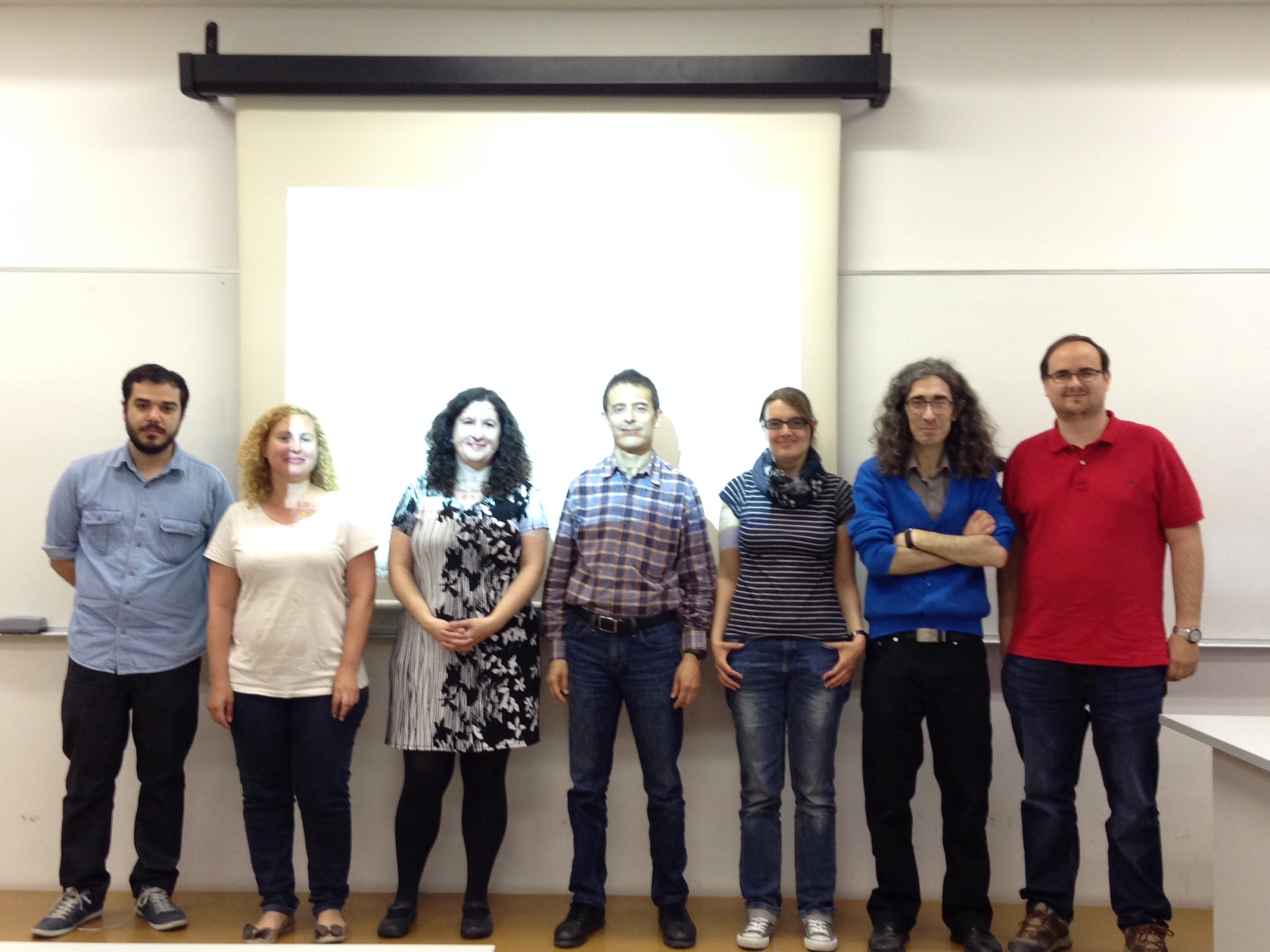Symplectic techniques in dynamical systems and mathematical physics
Symplectic techniques in dynamical systems and mathematical physics
–
Room 003, Facultat de Matemàtiques i Estadística, UPC
Symplectic geometry studies manifolds endowed with a closed non-degenerate 2-form. The non-degeneracy of this 2-form allows to associate vector fields to functions (Hamiltonian vector fields). This assignment is key in this theory.

–
Room 003, Facultat de Matemàtiques i Estadística, UPC

Symplectic geometry studies manifolds endowed with a closed non-degenerate 2-form. The non-degeneracy of this 2-form allows to associate vector fields to functions (Hamiltonian vector fields). This assignment is key in this theory.
Amadeu Delshams (UPC)
Eva Miranda (UPC)
Ignasi Mundet (UB)
Summari
Symplectic geometry studies manifolds endowed with a closed non-degenerate 2-form. The non-degeneracy of this 2-form allows to associate vector fields to functions (Hamiltonian vector fields). This assignment is key in this theory. The very Hamiltonian equations can be seen as the equations of the flow of Hamiltonian vector field associated to the energy (Hamiltonian). In contraposition to Riemannian manifolds, Symplectic manifolds have no local invariants other than their dimension but the study of global invariants or local invariants with additional structures makes this theory into a fascinating subject that places itself in the crossroads of Geometry, Topology and Dynamics.
This is a course on Symplectic Geometry and Topology with an eye towards applications in Hamiltonian Dynamics. The first part of the course in classical Symplectic Geometry settles the language and tools of the theory, and it focus on integrable Hamiltonian systems, group actions Poisson Geometry. In the final part of the course, the theory of intersection of Lagrangian submanifolds is applied to the invariant manifolds of invariant objects of Hamiltonian systems, like equilibrium points, periodic orbits, invariant tori, the Poisson systems are introduced in a natural way in Celestial Mechanics close to the collision or infinite manifolds, and the principle of minimal action is broadly applied in several settings, like billiards, elliptic fixed points of area-preserving maps, and positive definite invariant tori.
The course has a multidisciplinary approach and will therefore be of interest to both Geometers (Differential and algebraic) and Dynamicists, as well as appealing to graduate students working with partial differential equations and Mathematical Physics. In particular, the interaction between graduate students from these different areas will be promoted.
Contents
Part I: Symplectic Geometry and Hamiltonian actions (Eva Miranda)
- Basics in Symplectic Geometry.
- Symplectic and Hamiltonian group actions on a Symplectic Manifold.
- Integrable Hamiltonian systems. Arnold-Liouville theorem.
- Toric manifolds. Delzant theorem.
- Introduction to Poisson Geometry.
Part II: Symplectic Topology (Ignasi Mundet)
- Almost complex structures and pseudoholomorphic curves.
- Gromov compactness.
- Symplectic nonsqueezing.
- Floer homology. Arnold’s conjecture.
- Hofer’s norm on the group of Hamiltonian symplectomorphisms.
Part III: Applications to Dynamical systems (Amadeu Delshams)
- Intersection theory of Lagrangian invariant manifolds and perturbative setting.
- Symplectic normally hyperbolic invariant manifolds in Hamiltonian Systems, Scattering maps.
- Poisson structures. Applications to the Infinity and Collision Manifolds in Celestial Mechanics.
- Minimal Action in convex billiards (length spectrum: Can one hear the shape of a drum?), periodic orbits, caustics, integrability and non-integrability.
- Birkhoff normal forms.
Bibliography
- A. Cannas da Silva, Lectures on Symplectic Geometry, Lecture Notes in Mathematics 1764, Springer-Verlag, 2001 and 2008 (corrected printing).
- V. I. Arnold, Symplectic Geometry and Topology, J. Math. Phys. 41, 3307 (2000).
- B. Bramham and H. Hofer, First Steps Towards a Symplectic Dynamics, Surveys in Differential Geometry,Volume 17 (2012 127 – 178, also available http://arxiv.org/abs/1102.3723.
- V. Guillemin and S. Sternberg, Symplectic Techniques in Physics, Cambridge University Press, 1990.
Dusa McDuff and D. Salamon,Introduction to Symplectic Topology, Oxford University Press, 1998. ISBN 0-19-850451-9. - K. R. Meyer, G. R. Hall, D. Offin,Introduction to Hamiltonian dynamical systems and the N-body problem. Second edition. Applied Mathematical Sciences, 90. Springer, New York, 2009.
- L. Polterovich, The Geometry of the Group of Symplectic Diffeomorphisms,Lectures in Mathematics ETH Zurich, Birkhauser, Verlag, Basel, 2001.
- K. F. Siburg, The Principle of Least Action in Geometry and Dynamics.Lecture Notes in Mathematics, 1844. Springer-Verlag, Berlin, 2004.
List of Participants
| First Name | Middle Name | Email address | Affiliation | Degree | Area of interest |
| Joan | jgimenal8@alumnes.ub.edu | University of Barcelona | Master | dynamical systems | |
| Marc | Jorba | marc@maia.ub.es | Universitat de Barcelona | Master | Dynamical Systems |
| Arnau | arnauplanasbahi@gmail.com | UPC | Master | Symplectic Geometry, singularites | |
| Louis | louiscarlier@mat.uab.cat | UAB | Doctorate | algebraic topology, category theory | |
| Juan | Ramón | juan.ramon.pacha@upc.edu | UPC | Doctorate | Dynamical Systems |
| Marina | Gonchenko | mgonchenko@gmail.com | UB | Doctorate | Dynamical Systems |
| Teresa | García | mtgcia@gmail.com | UAB | Doctorate | |
| Carlos | Sáez | charlie1988@gmail.com | CRM | Master in Advanced Mathematics | Symplectic geometry and group actions |
| Anna | anna.kiesenhofer@gmx.at | UPC | MSc | Symplectic forms with singularities | |
| David | rojas@mat.uab.cat | UAB | PhD Student | Mathematics | |
| Chara | chara.pantazi@upc.edu | UPC | Doctorate | Dynamical systems | |
| Rodrigo | Gonçalves | rodrigo.schaefer@upc.edu | UPC | PhD student | Math (Dynamical Systems) |
| Daniel | dani10sa2@hotmail.com | UPC | Doctorate | ||
| Alex | alex@maia.ub.es | UB | Doctor | Dynamical systems |
